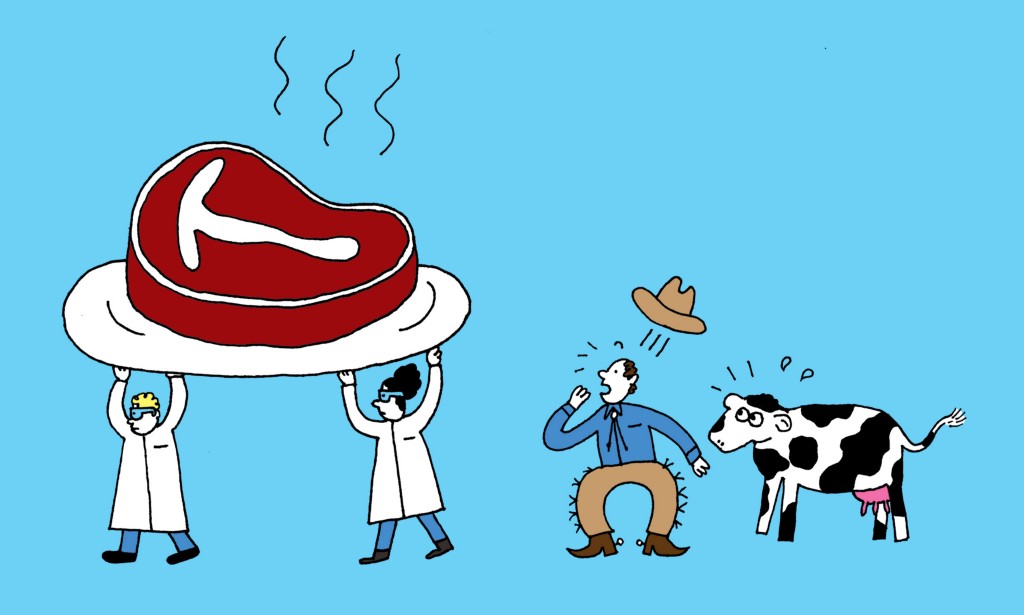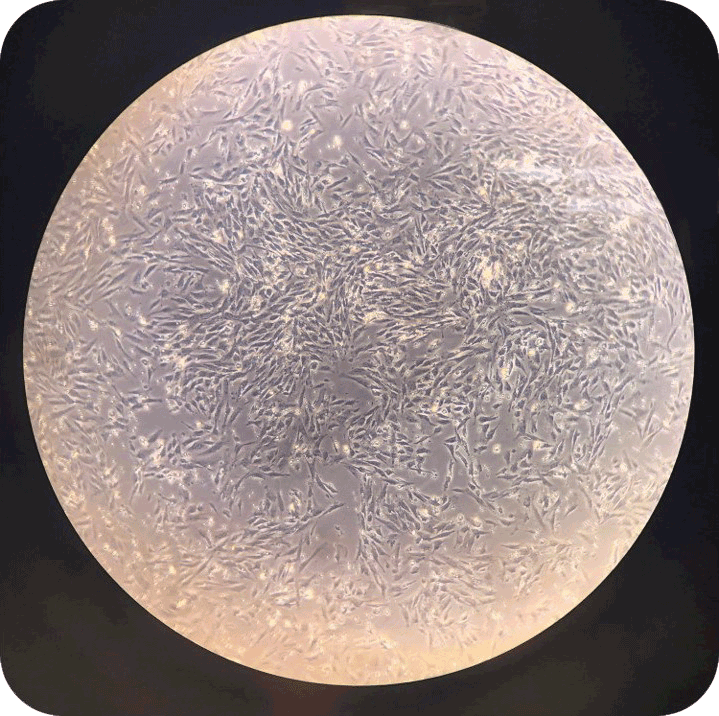These startups are brewing up ways to save seafood, turn gas into protein, and make dairy alternatives less gross.
A hungry world demands more and more protein. Producing it today requires billions of livestock animals and vast stretches of land where plants are grown. But what if you could get microorganisms to do a lot of that work? That’s the idea powering the three startup companies featured below.
Countless companies have plans for making food taste better, cost less, or be more sustainable. Some are growing meat from animal cells. Others are growing produce in “vertical farms” in big cities. Then there’s the path all three of these startups are taking: engineering yeast or other microbes to churn out food for us and food for the things we eat. Even though you can’t see these microscopic processes in action, it’s an idea worth watching.
Milking Yeast for All It Is Worth
By Elizabeth Preston
Ryan Pandya and Perumal Gandhi didn’t know each other in April 2014, but they both knew vegan cheese was terrible. They had both recently given up animal products “but were sort of hating it,” Pandya says, and wondering if they could use their biotech backgrounds to create earth-friendly dairy that tasted better. Isha Datar, CEO of the research institute New Harvest, knew both men and realized they’d had the same idea at the same time. She connected Pandya and Gandhi and suggested they start a company.
They named their company Muufri (say it out loud and you’ll get it) but later changed it to Perfect Day. The startup uses genetically engineered yeast to manufacture casein and whey — the proteins in cow’s milk — and adds them to vegan dairy products. Most yeast turn their food into exponentially more yeast cells, but Pandya and Gandhi are engineering theirs to turn food into milk proteins while still maintaining a stable population. “A herd, if you will,” says Pandya, the CEO.
Real milk isn’t only made of proteins. It also contains milk sugar (as any lactose-intolerant person is painfully aware) and milk fats. But milk protein is what gives some foods their distinctive textures, Pandya says, like the stretchiness of mozzarella. You can use plant molecules to replace milk sugar (as in lactose-free milk) or milk fat (as in some processed cheeses) without harming the texture much. But it’s harder to replace milk proteins. Their absence is notable in most vegan dairy substitutes. Gandhi says dairy alternatives have seemed to him “like they were held together with glue.”
The team has already prototyped several cow-free dairy foods. The best one so far, Pandya says, is yogurt, which they make using the same bacterial cultures and technique as regular yogurt, but with their yeast-based milk instead of animal milk. They’ve also experimented with soft cheeses, ice cream, and butter. As a beverage, their yeast-based milk is less convincing, Pandya says. It’s good enough to combine with other ingredients for cheese or yogurt, but doesn’t stand up yet on its own. “I hesitate to call what we’ve made ‘milk,’” Pandya says. But he thinks that will change as the team tweaks its genetically engineered yeast to produce a closer facsimile of cow’s milk.
The company has raised $25 million and secured its first patent, and is talking to large food and dairy companies about potential partnerships. These partners may be interested in sustainability — making milk more efficiently by leaving cows out of it — or in meeting consumer demand for better dairy alternatives.
Meanwhile, though, the company’s founding vegans have relaxed their own diets and gone back to eating cow-milk products for comparison to their own. As Pandya says, “It’s tough to run a dairy company and be someone who doesn’t consume dairy.”

Converting Gas into Food
By Andrew Rosenblum
India has far too much methane. It wafts up from the world’s largest herds of cattle, from oil production, and from decomposing trash — 90 million tons of it every year. Methane accounts for 29 percent of India’s greenhouse gas emissions, about twice the average proportion in other countries.
When Ezhil Subbian thinks of all that methane, she thinks of food.
That’s possible because of funky microbes that transform methane into useful products. String Bio, Subbian’s startup in Bengaluru, India, is filling big vats with these single-cell organisms, nurturing them inexpensively with India’s surplus methane, and getting them to crank out animal feed that she expects to be 30 to 40 percent cheaper than other proteins when it hits the market next year. “Methane is the cheapest carbon available,” Subbian says.
The workhorse microbe is a methanotroph, which typically lives in marshes, near underwater vents, or in landfill, and has evolved to use methane gas as its only source of carbon and energy. Methanotrophs metabolize the methane into proteins that they store in their cell walls, sort like of how the human body converts food into fat.
String Bio wants to scale up this natural process to produce on the order of 200,000 to one million tons of protein per year. That would be a substantial portion of the world’s total supply of feed for livestock and fish farms, which require 150 million to 200 million tons of protein per year, Subbian says. The product could also be the basis of alternative proteins for people, too.
The company places the methanotrophs in large tanks called bioreactors, allowing for precise control of conditions like temperature and pH. Pump in methane from anywhere, whether it’s the excess generated by oil production or the biogas collected at a landfill or sewage treatment plant, and the methanotroph will create a brew that contains proteins, water, and carbon dioxide. String Bio then dries out the methanotroph brew and turns it into food pellets.
To make animal feed, String Bio uses naturally occurring methanotrophs. But it also wants to use methane to produce chemicals. For that trick, the company works with a strain of methanotrophs that has been genetically engineered to produce chemicals useful in industry, such as lactic acid and succinic acid. Lactic acid is a key ingredient in certain forms of packing materials. Succinic acid can be used to make biodegradable polymers.
Subbian says her company’s animal feed will be purer than competing products, with no risk of the pesticide residue that has been found in some plant-based feed for farm animals and fish. But String Bio’s biggest advantage might simply be how much food it can eventually produce. Says Subbian: “Methane is scalable.”
A Biotechnology That Can Save Sushi
By Andrew Rosenblum
You are what you eat, even if you’re a fish grown in an underwater pen. Researchers at Scotland’s University of Stirling discovered in 2016 that that farmed salmon had 50 percent less omega-3 fatty acid than they did in 2011 — and that was because the percentage of oily fish in their diets had fallen from 80 percent to 20 percent.
Those nutrient-poor salmon could be a sign of things to come at burgeoning fish farms. Humans are overfishing the small species like sardines and anchovies that had been used to feed larger fish on farms. Now, instead of giving pellets consisting mostly of ground-up fish to their salmon, the farms are stuffing them with feed that consists of a much higher percentage of soy and other fillers that lack key nutrients like fatty acids. With the world’s supply of farmed fish projected to explode from 50 million tons in 2010 to over 93 million in 2030, according to the World Bank, “there just isn’t enough fish oil to go round,” a fish nutritionist and marine biologist, Rick Barrows, said at the SynBioBeta conference last fall.
KnipBio can vary its recipe so that the product includes nutrients such as taurine and carotenoids—the stuff that give salmon and shrimp an appealingly pink flesh.
KnipBio, a 10-person startup based in Lowell, Massachusetts, is unleashing the power of biotechnology on the problem of fish nutrition.
Methylobacterium extorquens is a microbe typically found munching the alcohols excreted by leaves or by rotting fruit. KnipBio is taking advantage of that process and tweaking it a bit so that the microbes produce fish meal.
KnipBio’s bioreactors are home to both genetically modified and naturally occurring strains of m. extorquens. Add methanol derived from natural gas to the tank, and out comes a broth rich in protein. That liquid is later dried in a centrifuge, leaving behind pellets of fish food.
Other companies do something similar with algae rather than bacteria as the starting point. After all, algae is a good source of those fatty acids that make fish so healthy. But KnipBio’s vice president of R&D, Catherine Pujol-Baxley, says the stuff m. extorquens produces is an ideal complement to algae in fish diets. KnipBio can vary its recipe so that the product includes nutrients such as taurine and carotenoids. The latter ingredient is the most expensive additive in commercial meal; salmon, trout, and shrimp without carotenoids don’t have an appealingly pink flesh.
So how does fish fed on this stuff taste? A company called Kampachi Farms mixed KnipBio’s feed into the diet of sashimi-grade yellowtail it raises in deep-sea pens floating off the coast of the big island of Hawaii. According to Pujol-Baxley, a 70-person tasting panel at Oregon State’s Food Innovation Center didn’t detect any difference in the taste of the sashimi after the change in feed.
In January, KnipBio announced that it had scaled up from a small trial facility to a 20,000-liter bioreactor, capable of producing a metric ton of KnipBio Meal every week. Pujol-Baxley says the company plans to conduct commercial trials this year, testing different feed blends on various farms with fish at different life stages. It’s a key step toward a full commercial release in 2019, when we’ll really see whether the idea will sink or swim.









